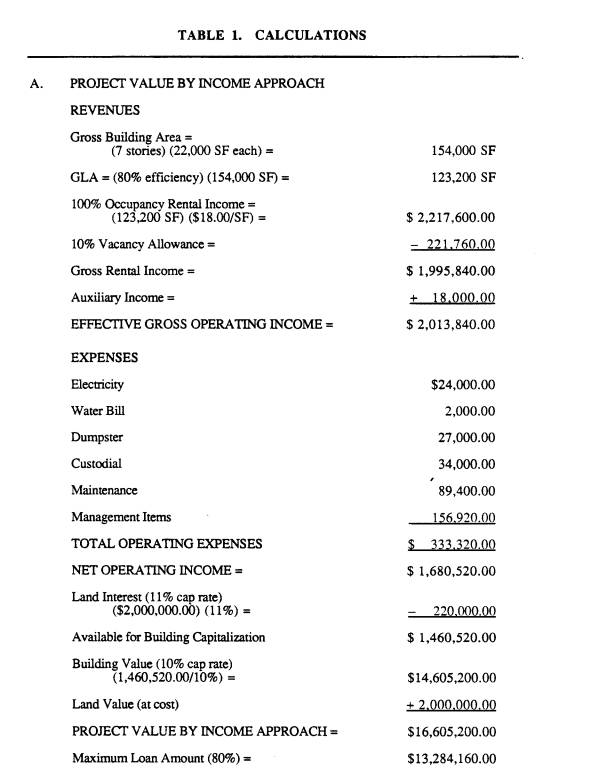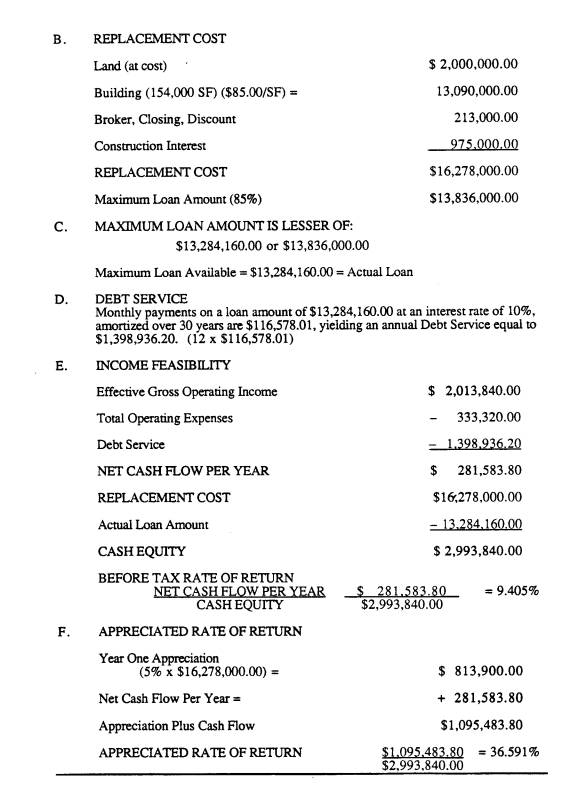(pressing HOME will start a new search)
- ASC Proceedings of the 25th Annual Conference
- University of Nebraska-Lincoln- Lincoln, Nebraska
- April 1989 pp 44-48
|
(pressing HOME will start a new search)
|
|
CONSTRUCTION
FINANCE MODELING FOR INCOME PROPERTY
|
Francis
M. Eubanks |
| This
discussion will cover financial modeling for income producing properties
in the built environment. Such properties include apartment projects,
motels, hotels, strip shopping centers, regional shopping malls,
office parks, professional parks and multi-story office building
complexes. The objective is to introduce
and inform the reader about financial modeling for Value By Income
Approach analysis and Income Feasibility (rate of return) analysis
techniques. These two very powerful tools are in various stages of use
and refinement by both lenders and owner-developers alike. These
techniques, and their underlying principles, have many applications in
decision making that drive the development, design, general contracting
and construction management processes. Basically, Value By Income
Approach involves assigning a dollar value to a property based on its
ability to produce income and Income Feasibility involves calculating a
before tax rate of return on the owner's or owner-developer's cash
investment in a property. |
INTRODUCTION
It
is unlikely that a developer will have the cash equity to construct his project
without borrowing. Even if he did have the cash, he would still resort to
borrowing in order to leverage his own funds so as to increase his rate of
return. Also, in order for the general contractor to be successful in borrowing
short term funds, when needed, to meet payrolls and material invoices, he
frequently must demonstrate that the owner or owner-developer has a firm
construction loan enabling him to pay the monthly draws. It is, therefore,
generally necessary that an owner or developer secure a loan commitment prior to
obligating himself to a contractor, construction manager, or even an architect
for any substantial amount of dollars.
Before
making loan commitments, lending institutions examine the owner's or
owner-developer's balance sheet and revenue and expense statements as well as
his record of experience with similar projects in order to determine his
financial strength and stability. In addition, the project itself has to be
examined in terms of its ability to pay for itself and make a reasonable rate of
return for its owner. This latter examination involves some model for valuation
based on income production and some model for projecting a rate of return.
When
an individual desires to finance a home using a purchase money mortgage, the
lending institution evaluates his net worth as well as the cost (and comparable
market value) of the home being financed. However, the lending institution also
examines the individual's income and expense stream in order to determine the
individual's ability to make his monthly payments. Value By Income Approach will
be seen to be a highly similar technique.
Lending
institutions do not want to become owners by virtue of the borrower's default.
They are in business to collect interest on loans. Lenders seek evidence that
the project itself will provide the owner or owner-developer with the necessary
proceeds to retire the loan as well as an attractive rate of return. Lenders
therefore need tools for evaluating projects based on the expected income and
expense streams for those projects.
THE
METHOD
There
is no substitute for a thorough analysis of: (a) current market needs; (b)
current and planned construction activity; (c) current rental rates and vacancy
rates; (d) population movement; (e) the availability of transportation, schools,
shopping and recreation; (f) accurate estimates of site development costs and
construction hard and soft costs. All of these items must be meticulously dealt
with in a feasibility study. The valuation of a project based on its income
production potential can only be a "capstone" for a thorough
feasibility study.
The
capstone model includes a "Project Value by Income Approach"
calculation which, typically, is the "Value" in a "Maximum Loan
To Value Ratio" (generally 80%) used to determine the maximum loan amount.
Once the maximum loan amount is determined, a calculation called "Income
Feasibility" (rate of return) is made.
The following case study calculates a Project Value By Income Approach (Part A) for an assumed midrise office building and then summarizes actual Replacement Cost (Part B) for the same project. Income Feasibility (Part E), which draws upon most of the same data plus debt service, is used to compute a "cash on cash" rate of return (cash coming out as pre-tax profit divided by the amount of cash equity the owner or owner-developer had to take out of his own funds to construct the facility). The rate of return so generated may be likened to the rate of interest earned on the owner's or owner-developer's investment. If a better rate of return could be earned on some other investment, or a similar rate of return on a "safer" investment, the project might never be built. If appreciation is likely, we might do well to consider it (Part F).
CASE STUDY
Kenny
Mothy and Rick Ford have applied for a loan to develop a midrise office
building. It is necessary to determine the (A) Project Value by Income Approach,
(B) Replacement Cost, (C) Maximum Loan Amount Available, (E) Before Tax Rate Of
Return, and (F) Appreciated Rate of Return after one year of operation using 5%
appreciation per year.
The
project is to be a seven story office building with 22,000 SF per floor with a
Gross Leasable Area (GLA) equal to 80% of Gross Building Area. Market analysis
indicates a rental rate of $18.00/SF per year and a Vacancy Rate of 10%. The
building includes a spa and health club which are expected to produce Auxiliary
Income of $18,000.00/year.
Electrical
power bills are to be prorated on a square footage basis with Rick and Kenny
picking up an estimated cost of $24,000.00 per year to cover "public
areas" and unoccupied spaces. Rick and Kenny are to pick up the entire
water bill, estimated at $2,000.00 per year and the dumpster, estimated at
$2,700.00 per year, as well as custodial expenses for all "public
areas," estimated at $34,000.00 per year, and maintenance of "public
areas" estimated at $89,000.00 per year. Rick and Kenny estimate management
expenses (including payroll, property taxes, insurance, supplies, etc.) to be
$156,920.00 per year.
The
lender's current terms are 10%, compounded monthly, on 30 year loans and
capitalization rates are 11% for land and 10% on improvements. Maximum loan
amount is smaller of 80% of Value By Income Approach or 85% of Replacement Cost.
Construction
cost is $85.00 per square foot, including Architect fees. Brokerage fees, loan
discounts, closing costs and property tax during the construction period are
estimated to be $213,000.00. Construction Loan Interest (which will be rolled
into the permanent loan) is estimated to be $975,000.00.
EXPLANATIONS
Project
Value By Income Approach (Part A): A value is placed on the project by
"capitalizing" its Net Operating Income. Usually, land cost and
building cost are capitalized at different rates since they involve different
risk factors.
A
"capitalization rate" is essentially a lender prescribed interest
rate. Annual Net Operating Income is divided by the capitalization rate to
determine Project Value (much as annual interest divided by interest rate equals
principal).
Revenues
(income items) are estimated and combined and Expenses are deducted to arrive at
Net Operating Income. Net Operating Income is the amount available to pay taxes,
the mortgage, and profit.
The
capitalized value of the project's Net Operating Income is its Value By Income
Approach. In our case study, the lender will loan a maximum of 80% of this
value.
Replacement
Cost (Part B): This is the actual cost of producing the project. It includes all
construction costs, land costs, interest accumulated during the construction
period, architect fees, loan closing and loan brokerage fees, tenant allowance
costs, all costs that must be paid to produce the project. The lender will
usually require the borrower to pay a certain minimum percentage of this cost
from his own funds (else, the borrower might borrow more than it costs to
construct the project). In our case study, the lender has set 85% of this value
as a maximum loan.
Maximum
Loan Amount (Part C): Note here that, in our case study, the Value By Income
Approach exceeds the Replacement Cost. In other words, the value of our project
as an operating entity exceeds the cost of creating it. Traditionally, a Loan To
Value Ratio was applied to the (lower of) Replacement Cost (or to adjusted sales
prices of recently sold "comparable" properties) to determine maximum
loan amount. The introduction of Value By Income Approach has created an
interesting dilemma which has often resulted in owners or owner-developers being
able to borrow a higher percentage of cost for their projects.
Income
Feasibility (Part E): Here we go back to the Net Operating Income from Part A
and subtract the amount actually required (Part D) to make the mortgage payments
(note that we still have not allowed for taxes or profit) to arrive at an income
comparable to income from other forms of investment. We then divide that income
by the actual amount of dollars the owner put into the project from his own
funds. This is a "cash on cash" return, similar to cash interest
received on a cash investment in a savings account.
Appreciated
Rate of Return (Part F): Most real estate developments do appreciate in value.
In our case study, the basic Before Tax Rate Of Return was a rather poor 9.49%.
The owner or developer might do well to put his money into some lower risk
investment and forego construction of this project. However, the Appreciated
Rate Of Return, 34.49% (assuming a holding period of one year), illustrates the
magic of leverage often available in real estate development.
CONCLUSION
The
Project Value By Income Approach and Income Feasibility Analysis can be very
powerful tools for both lender and borrower alike. Traditionally, valuations
have been made in terms of Replacement Cost or what appraisers believe to be
"comparable properties" with no consideration given to income
producing potential. The analysis made no serious effort to recognize that it is
the income stream produced by the property that ultimately pays the mortgage and
produces income for its owner. These two tools, by design, relate the value of
the property to its ability to retire its own mortgage and provide a means of
measuring the property owner's rate of return on his investment.
Inasmuch
as an income producing property is constructed, bought or sold for the purpose
of producing income, a method of measuring its value based on that income and
measuring the expected rate of return, also based on that income, is essential
to the industry. These two tools respond to that need.
It
can be seen readily in observing the calculations that accuracy in determining
Value By Income Approach and in projecting Income Feasibility is heavily
dependent upon the reliability of the data used. Use of these models, therefore,
should be limited to those entities who have the necessary resources to gather
or purchase quality data.
 |
 |
REFERENCES
|